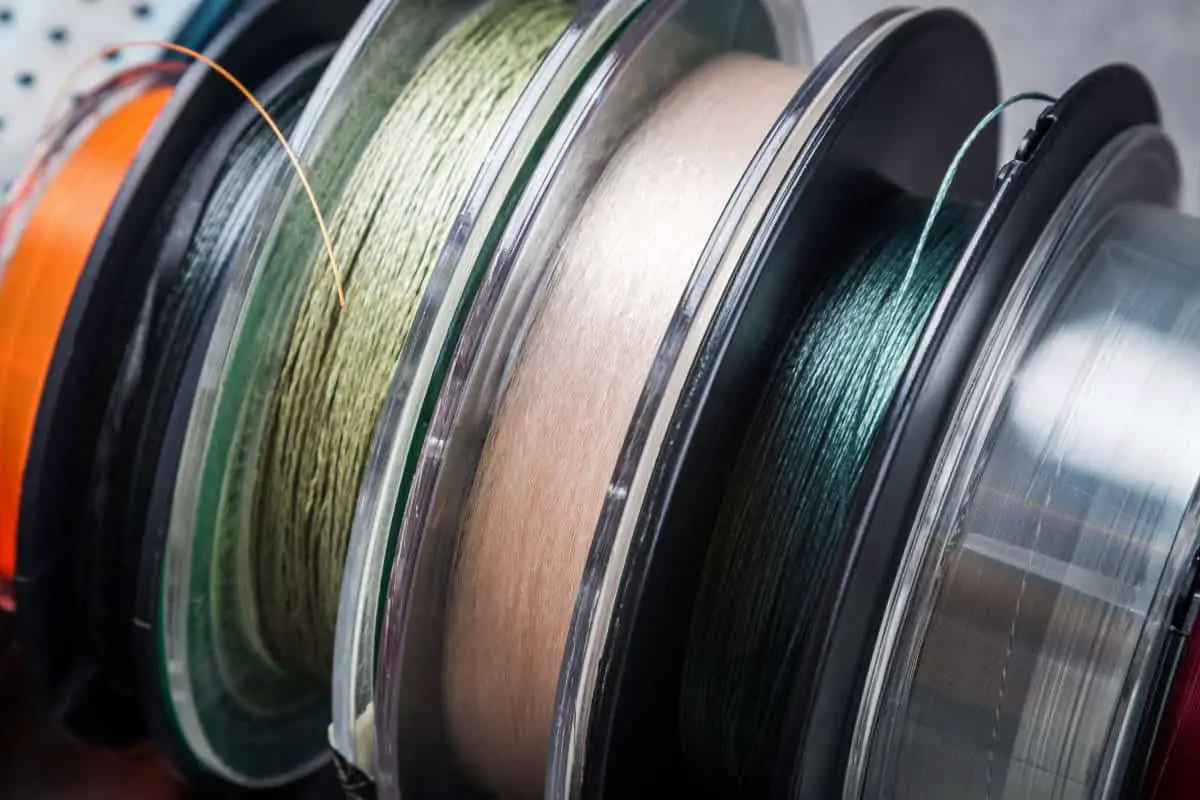Fishing line has a wide variety to choose from. The different types of fishing lines are categorized into three major groups: and they are the monofilament, fluorocarbon, and braided lines.
As a beginner, I’ve wondered which one is the best for surf fishing. So, I did some research, and after reading countless articles online, this is what I found. So, what is the best line for surf fishing?
The best line for surf fishing is the braided fishing line. It has an excellent strength to thickness ratio, minimal stretch, low visibility, low memory, also highly recommended by professional anglers.
Let’s explore the different types of surf fishing lines in more detail below. This will further explain why braided lines are the ‘best’ choice.
It’s also important to note that each line option has its own set of attributes (both positive and negative) and the ‘best’ choice depends upon the angler’s surf fishing needs and personal preferences. That being said, let’s begin.
Monofilament Fishing Lines
Monofilament (or ‘mono’ for short) is a single strand of material, unlike multi-filament line that is fused, braided or bundled together using many strands of material.
Monofilament lines are usually made from nylon. Different types of nylon fibers are combined to form multi-polymers that produce varying degrees of stretch, strength, abrasion, and resistance.
are usually made from nylon. Different types of nylon fibers are combined to form multi-polymers that produce varying degrees of stretch, strength, abrasion, and resistance.
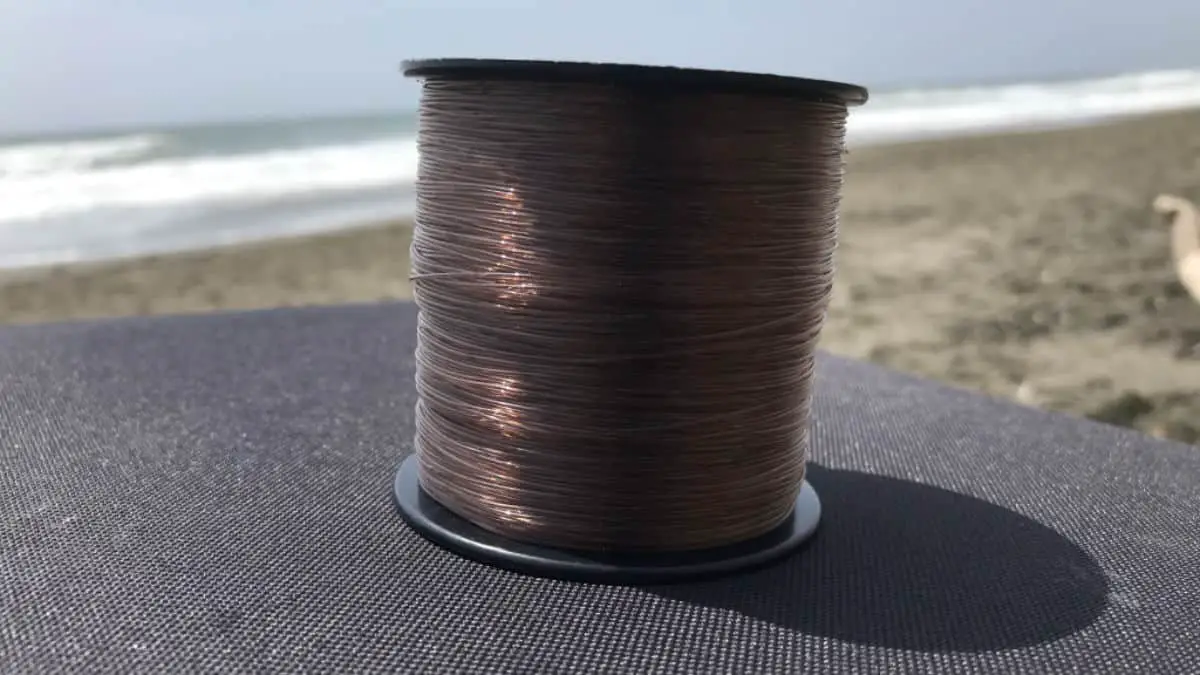
Pros of Using Monofilament Fishing Lines for Surf Fishing
Benefits of monofilament include the following:
It is easy to handle. Due to monofilament lines flexibility, mono is very easy to use and will work well in some surf fishing situations. Because of its ‘limpness,’ it is also easy to control and to cast. It is an excellent choice for first-time anglers.
It has good elasticity. Mono stretches more than fluorocarbon (or ‘fluoro’) with a forgiveness factor second to none! If you end up setting the hook too hard or your drag gets caught don’t worry, because mono will compensate for this by stretching up to twenty-five percent more than all other lines. This will also help stop the hook from ripping a hole in the fish’s mouth, which would likely cause it to break loose.
It has good shock strength. Shock strength is the ability of the fishing line to absorb energy. It is an important factor when your line is tested by the sudden impact of a hard hook-set or the violent thrashing of bigger fish.
Monofilament lines are larger in diameter. Monofilament lines are much thicker than fluoro lines. While the larger diameter can affect how deep your lures will go, you can still use the extra thickness to your advantage. For example, when fishing in ‘cover’ (grassy, weedy areas), the added thickness makes the monofilament line more abrasion-resistant.
It has a slower sink rate. Because it has almost neutral buoyancy, monofilament lines will sink slowly, preventing the bait from dropping too quickly. This makes mono fishing lines an ideal choice for topwater surf fishing situations.
It is also available in a wide range of colors. Mono is an easier material to tint than other lines, so it comes in a variety of color options. You can choose watercolors, such as green or blue, or opt for a classic clear line. These all have low visibility, greatly increasing an angler’s chances of catching more fish.
Knot-friendly. Because of its makeup, monofilament line is easy to tie into knots. Even tight, strong knots will not affect its overall strength.
Monofilament is inexpensive. Mono is very affordable, more so than other lines. It consistently ranks as one of the sport’s top-line choices and will give you the most ‘bang for your buck’.
Cons of Using Monofilament Fishing Lines for Surf Fishing
Just as there are benefits to using monofilament, so too are there downfalls (but few). These include the following:
It is less sensitive to changes in the water. Because of its highly-stretchy nature, it is less susceptible to subtle line bites or changes in seabed composition. You are then less likely to be aware of what your lure is doing which can negatively affect your success rate in catching fish. In this case, a fluorocarbon line is the better option.
It also has less tensile strength. Monofilament line is more likely to ‘snap under pressure.’ This means that your lures will not run as deep as they would using a fluorocarbon.
Mono is more likely to weaken in the sunshine. Finally, monofilament lines are more susceptible to UV light and will weaken after prolonged sun exposure. Let’s be honest though; it would likely take hundreds of hours of sunlight to affect it, professional anglers still recommended that you change the nylon mono line once a year. Which is just proper maintenance. (Source )
)
Fluorocarbon Fishing Lines
Fluorocarbon (also known as ‘fluoro’) is line made from fluorine, chlorine, carbon, and hydrocarbon synthetic fibers. Because the particles in this type of line are packed so tightly together, it is very dense and heavy, more so than monofilament.
(also known as ‘fluoro’) is line made from fluorine, chlorine, carbon, and hydrocarbon synthetic fibers. Because the particles in this type of line are packed so tightly together, it is very dense and heavy, more so than monofilament.
Its visibility, durability, and stretch are also quite different than monofilament and will, thus, have its unique performance in the water.
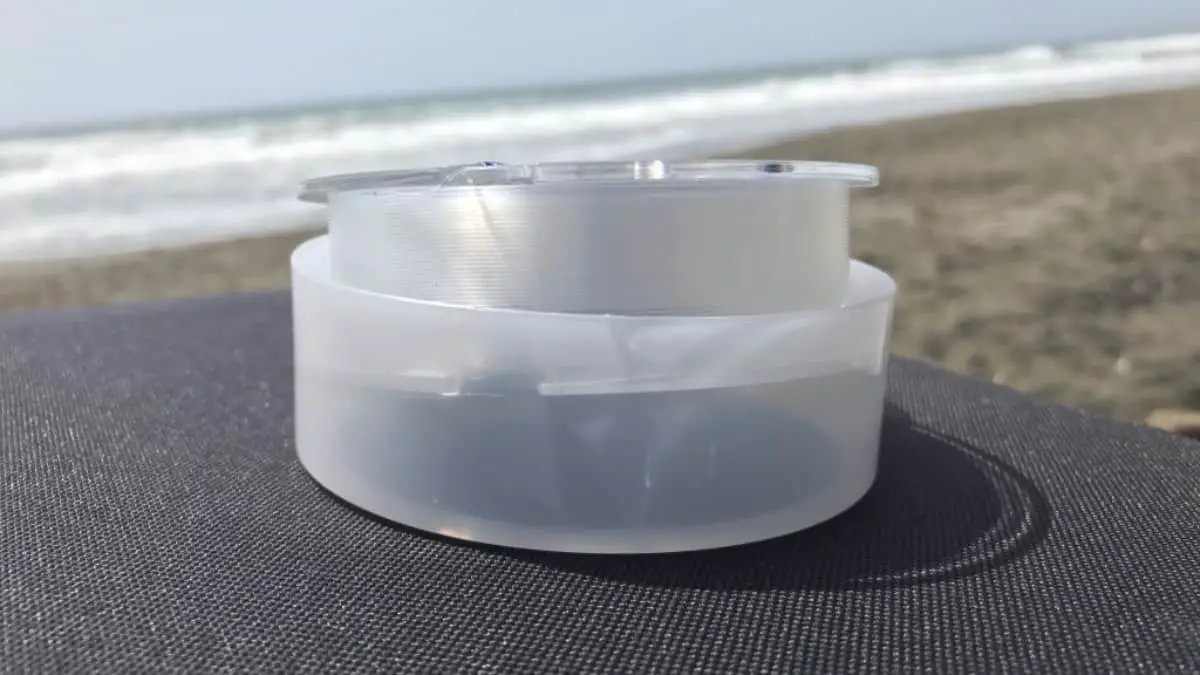
Pros of Using Fluorocarbon Fishing Lines
Benefits of using fluorocarbon include the following:
include the following:
It has low visibility. The best thing about fluoro lines is that they are almost invisible underwater. This is a huge benefit to those fishing in clear waters or for catching fish with a ‘skittish’ nature.
Abrasion resistance. Fluoro lines are amazingly abrasion resistant, which means it is great for fishing in areas with thick cover. It is also perfect for dragging bait along the seabed.
Highly sensitive. Fluorocarbon is very sensitive and will let you know when fish are nibbling or when your lure has reached the seabed. Because it sinks so much faster than monofilament lines (for example), there is also less ‘slack’ between the lure and tip of the fishing rod.
UV resistant. Because of its thickness and abrasion resistance, fluoro lines will not weaken from sun exposure and will last much longer than nylon-based monofilament lines.
Zero water absorption. Fluoro lines do not absorb water (line monofilament lines do). So, they perform the same way on the top of the water as they do underneath it! It is this consistency that makes the line so useful to anglers.
Strong hook-sets. What fluorocarbon lines lack in a stretch, they make up for in strength. They provide anglers with solid hook-sets (and short or long distances) which is a definite plus!
Thicker diameter. The thickness of this line is what gives it such great strength and resistance to breakage. The added benefit of its almost-invisible nature makes it a great choice for anglers, as fish can barely see it and will not ‘spook’ as easily.
Cons of Using Fluorocarbon Fishing Lines
Just as there are many ‘pros’ to using fluorocarbon , there are also some ‘cons.’ These include the following:
, there are also some ‘cons.’ These include the following:
Less manageability. Fluorocarbon lines are stiffer than other options which makes it harder to control. Seasoned anglers may do well with fluorocarbon, but it is not a good choice for beginner anglers.
Reduced shock strength. This means that the fluorocarbon lines do not absorb as much energy as other lines (like mono) and thus will not withstand strong hook-sets or rapid head shakes from aggressive fish as well as monofilament lines.
lines do not absorb as much energy as other lines (like mono) and thus will not withstand strong hook-sets or rapid head shakes from aggressive fish as well as monofilament lines.
Faster sink rate. Fluoro sinks faster than other line types and is not as good for topwater fishing using small baits. The professionals who choose to use this line do so for its ability to achieve greater depths in both in trolling and casting conditions.
Reduced knot strength. Fluoro is not as knot-friendly as mono and will fail if you do not wet the line first. But, a knot tied properly on a pre-wetted line will be very strong. (Source )
)
Braided Fishing Lines
Braided fishing lines were originally made from natural fibers, such as cotton or linen. The modern-day versions, yet, are comprised of human-made materials that are woven together.
were originally made from natural fibers, such as cotton or linen. The modern-day versions, yet, are comprised of human-made materials that are woven together.
They are a top choice of anglers worldwide because they are easy to manage, flexible, and strong.
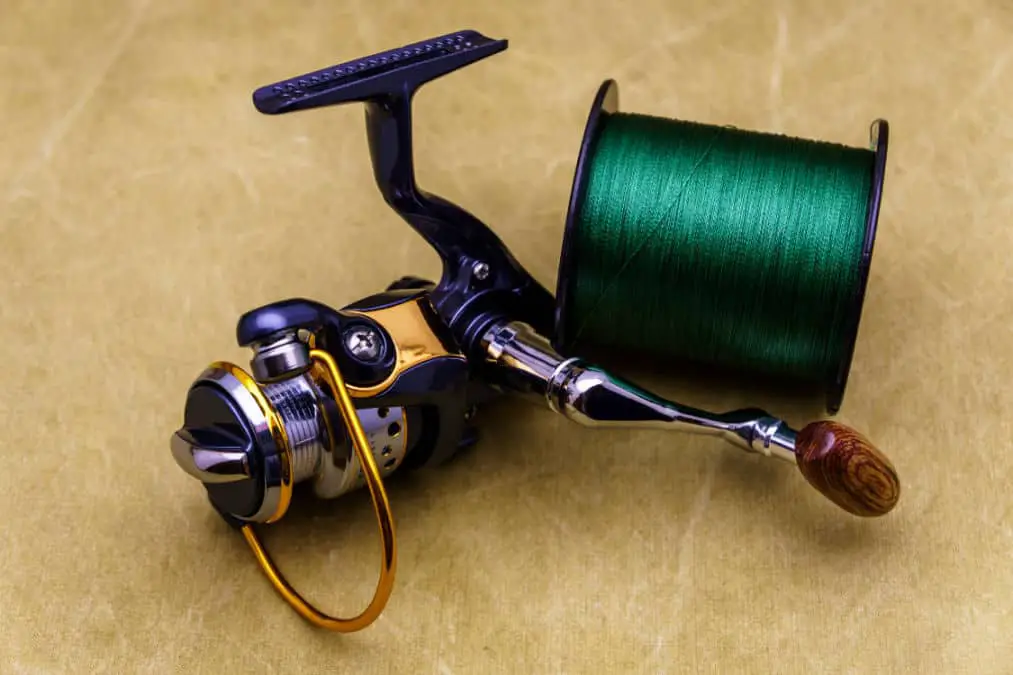
Pros of Using Braided Fishing Lines
Braided lines have many advantages in surf fishing which include the following:
have many advantages in surf fishing which include the following:
Super strength. Braided lines are very strong, while still maintaining a small diameter. This makes casting easier. They are next to impossible to break, even when snagged on weeds or grass. They will also straighten the hook, which allows you to retrieve the (often expensive) lures used in surf fishing.
Longer casting distance. These lines allow anglers to get the farthest casting distances possible, which is key to surf fishing. Longer casting distances equal bigger fishing areas which greatly improves your chances of catching more fish!
Smaller in diameter. The smaller circumference of the braided line means it will fly through the air and cut through the water with ease!
High sensitivity. Braided lines are very sensitive. They allow anglers to detect the slightest nibble or lightest snag. This greatly increases your catch rate as you know exactly what the line is doing.
Limited stretch. The limited stretch allows for greater sensitivity so that anglers can get a better feel of when fish are biting. This is very important in surf fishing.
Very flexible. Braided lines can be cast at long distances, and they typically float, which is vital in top-water fishing situations.
Excellent in heavy cover. Because of their strength, braided lines are great for fishing in highly wooded areas, providing a better chance overall of catching fish!
Longer reel life. If properly maintained, these lines can last for years, which can save you money in the long run!
Cons of Using Braided Fishing Lines
Like monofilament and fluorocarbon, braided lines also have their drawbacks. These include the following:
Highly visible. Braided lines are evident in the water, which makes them easy for fish to see! It is common for anglers to attach a mono or fluoro to the end of the braided line to act as a ‘leader’ for reduced visibility.
are evident in the water, which makes them easy for fish to see! It is common for anglers to attach a mono or fluoro to the end of the braided line to act as a ‘leader’ for reduced visibility.
Difficult to knot. Braided lines are hard to knot properly because they have a slippery surface that does not stretch very well. Extra time and care must be taken when attempting to knot a braided line.
More wear-and-tear on rods. Because it’s unbeatable strength, braided lines can put more stress on the rod and reel, which can cause premature wear.
More expensive. In general, braided lines are more costly than other types, like monofilament, for example. However, what they lack in affordability, they more than makeup for in performance!
Is Braid or Mono Better?
Now that we have learned the three types of fishing lines let’s look at the top two options (chosen by anglers), which are braided and monofilament, and compare them. For the intent of this article, we have made the case that braided lines have the advantage over monofilament lines.
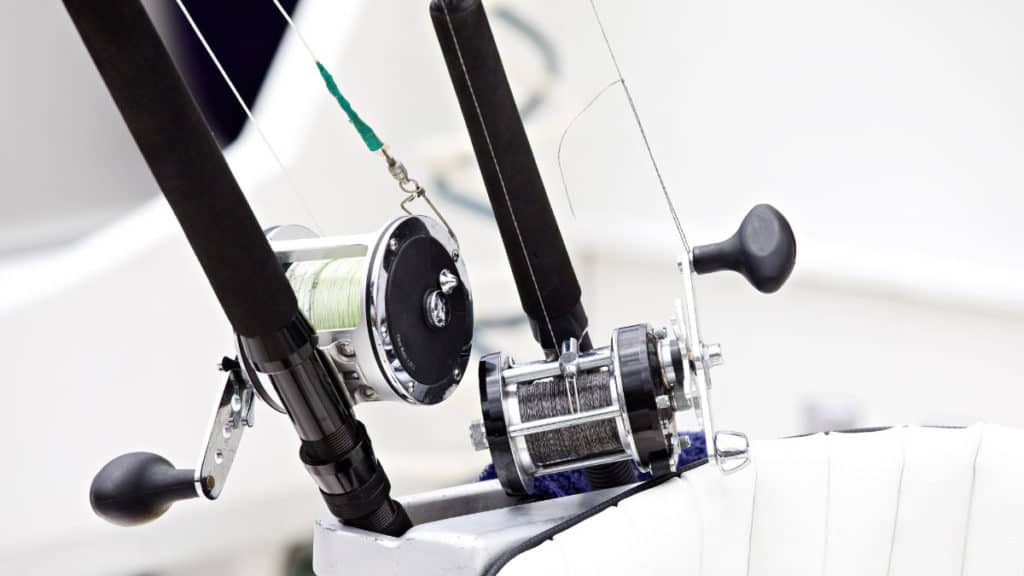
The consensus seems to be that braided lines are harder to spot in the water than monofilament lines, which significantly increases your chances of catching fish.
If you should catch your hook or lure on a weed or rock underwater, braided lines are incredibly strong (stronger than monofilament lines) and unlikely to break!
Braided lines are also easier to cast than monofilament lines. They have smaller diameters than monofilament lines which makes it easy to fit more lines on your reel.
are also easier to cast than monofilament lines. They have smaller diameters than monofilament lines which makes it easy to fit more lines on your reel.
Since you are surf fishing, the ability of your line to be cast farther can significantly affect your chance of landing a bite. This gives you a greater casting range and a more extensive water area to fish. Even heavy cover is no match for the braided line!
Braided lines are more sensitive than monofilament lines. This is due to their minimal stretch and superior strength. This allows you to feel the slightest line nibble or change in seabed composition. Anglers think this gives them an ‘edge’ when surf fishing as it know what their line is doing underwater.
Braided lines also have a significantly longer ‘shelf life’ than monofilament lines. Unlike monofilament lines that should be changed annually, braided lines (if properly maintained) can last for years! This is due to their smaller diameter. (Source )
)
Is Monofilament or Fluorocarbon Better?
Out of the three types of fishing line, fluorocarbon often seems to be the least popular option. It has pros and cons; just like monofilament and braided lines; however, it does not seem to be used for surf fishing as often as the other two types.
often seems to be the least popular option. It has pros and cons; just like monofilament and braided lines; however, it does not seem to be used for surf fishing as often as the other two types.
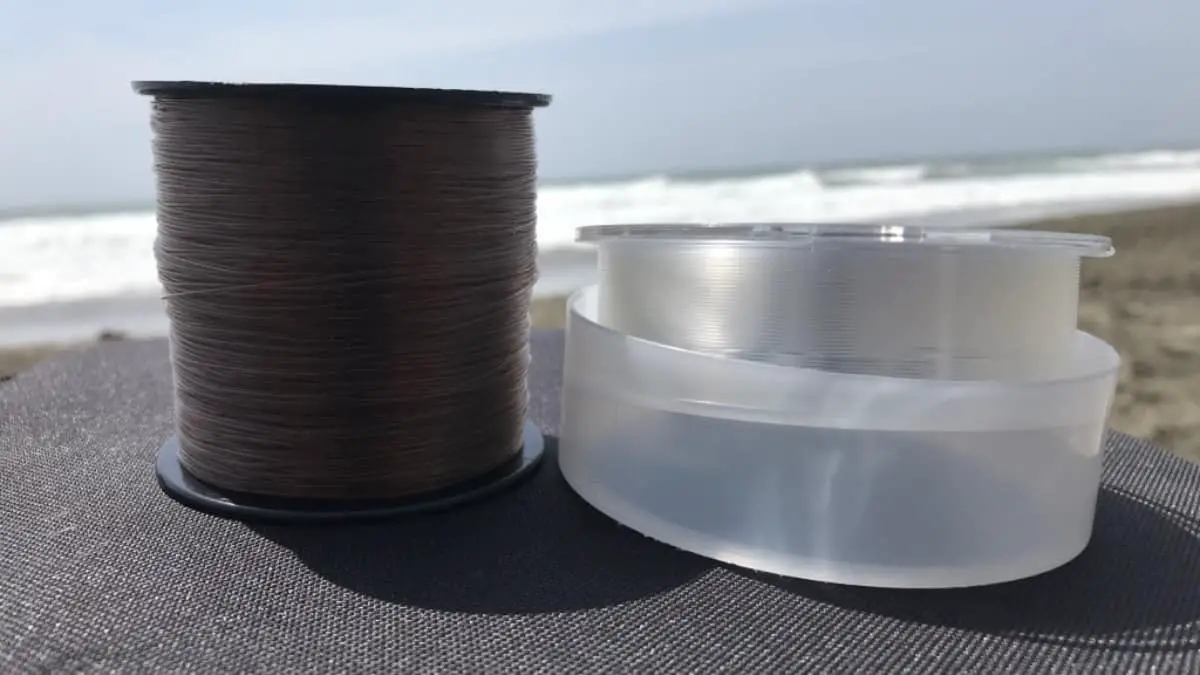
Fluorocarbon is similar to monofilament (nylon lines) in that it stretches pretty much the same way, at a similar distance range. However, mono or nylon lines have greater elasticity than fluoro lines, meaning they recover quicker with less chance of weakening.
Fluorocarbon is made up of very dense synthetic fibers. Therefore, it does not absorb water and will sink at a faster rate than monofilament. Because of this, it is not the right choice for fly anglers.
is made up of very dense synthetic fibers. Therefore, it does not absorb water and will sink at a faster rate than monofilament. Because of this, it is not the right choice for fly anglers.
While it would appear that fluorocarbon lines are virtually invisible in the water (making it less likely for fish to see them), there does not seem to be a significant difference between them and monofilament lines to warrant the higher price tag! Both appear to be equally visible (or invisible, if you prefer).
Monofilament provides excellent abrasion resistance, just like fluorocarbon. Mono is on par with fluoro in terms of a knot, tensile and shock strength, but at a third of the purchase price! So why not save some dollars and go with a monofilament line instead?
Should I Use Circle Hooks for Surf Fishing, and What Is the Best Line to Use with Them?
When it comes to surf fishing, considering the pros and cons of circle hooks is crucial. These hooks are designed to reduce fish mortality rates as they often hook the fish in the mouth, reducing the chance of injury. However, some anglers find that circle hooks can result in more missed strikes compared to traditional J-hooks. Choosing the best line to pair with circle hooks depends on various factors, such as the target species and fishing conditions.
is crucial. These hooks are designed to reduce fish mortality rates as they often hook the fish in the mouth, reducing the chance of injury. However, some anglers find that circle hooks can result in more missed strikes compared to traditional J-hooks. Choosing the best line to pair with circle hooks depends on various factors, such as the target species and fishing conditions.
Related Questions
Do fluorocarbon lines stretch as well as monofilament lines? Fluorocarbon lines are made from harder fibers than monofilament lines. This means they are more resistant to abrasion, breakage and ultraviolet light.
What is the best line for spinning reels? Anglers the world over have been asked this question. The top three answers usually include a braided line, a monofilament line, and a super line.
Anglers the world over have been asked this question. The top three answers usually include a braided line, a monofilament line, and a super line.
What is a super line? The super line is a type of fishing line that is also referred to as a multifilament line. It is braided and made up of polyethylene, which is extremely thin yet very strong.
What is the best kind of line? Though arguments can be made for one type of line over another (for (example, mono vs. braided), there is no ‘best’ kind of line. What is considered ‘best’ depends upon the various conditions, techniques, and fish being caught as well as the personal preferences of the angler.
Conclusion
In conclusion, you should now have a good understanding of the three different types of lines used in surf fishing. Each line has its own set of positive and negative attributes and knowing these will help you choose the ‘best’ one for your surf fishing needs and goals.
We have made the argument for braided lines being the ‘best’ choice for surf fishing. The key thing to remember, however, is that there is no ‘best’ choice. The choice depends entirely upon your individual needs and preferences as a surf fishing angler.
We hope this information has been useful to you. Now, you have the knowledge and understanding of the various line options available to anglers for surf fishing and can make the ‘best’ choice based upon what you have learned from reading this article. Good luck in your future surf fishing journey. Now, it is time to head to the beach and cast-off.

